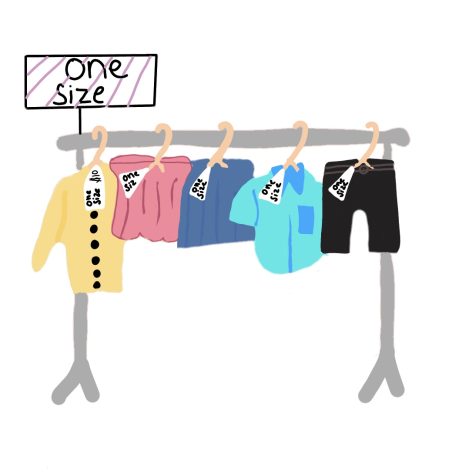One size does not fit all

The idea of one-size-fits-all removes the guesswork when shopping; there’s no need to wonder what size you are if a piece of clothing is designed for everyone. However, the description can be straightforward, yet deceiving. Although when consumers purchase these clothing designs, they could be disappointed to find that the clothing was indeed not meant to “fit all”.
The one-size-fits-all clothing has impacted the fashion industry, since its introduction in the 2000s. For instance, Brandy Melville, a brand that markets trendy fashion for teenagers, is known to produce one-sized clothing. Although stores like Brandy Melville seem inclusive because of their policy that one-size fits everyone, these brands create a false reality for people of different sizes. Brandy Melville has created an “idealistic” body type that affects the mental health of young teenagers.
According to SizeCharter, a clothing-based website, an average 20 year old woman’s bust size is 39 inches, the average waist size is 37.5 inches and the average height is 64 inches. However, the measurements for one-sized clothing are much smaller, with the average bust size being 28 inches, the waist being 22 inches, and the height being 67 inches. This observation demonstrates that one-sized clothing does not, in the slightest bit, fit the standards of an average woman. How can people rely on this concept if it doesn’t even correlate to the average body?
It is estimated that most women in the United States (U.S.) do not fit into one-sized clothing. In fact, CNBC states that 70 percent of women are plus-size, meaning they are over the size of 14. While people should not normalize unhealthy lifestyles, clothing stores need to accept the fact that the majority of people do not fit the clothing they design. The fashion industry’s choice to avoid this truth shows how inclusive they are.
How can people rely on this concept if it doesn’t even correlate to the average body?
— Cielo Muniz Sigala
To test out the one-size-fits-all concept, BuzzFeed tested out Brandy Melville’s clothing on five participants. SizeCharter mentions that “women ranging from a size 0 to a size 18 tried on tops, shirts, dresses, skirts, and shorts.” As expected, “none of the clothing items fit every woman on the panel.” In fact, each clothing piece fits the minority of the woman. Shirts “were too short, sleeves were too tight” and dresses seemed provocative.
Not only does the one-size clothing portray unrealistic standards, these standards play a part in many people’s self-esteem. This is becoming a step further in body acceptance. Mentioned before, Brandy Melville received a lot of backlash due to their one size clothing system. Ironically, the “perfect bodies” model these clothes, impacting the self-esteem of countless teenagers. As young generations view what seems to be the “perfect” body, this could lead to the fuel of dysmorphia and body shaming.
When customers are given the options of clothing that does not fit, it can trigger body dysmorphic disease. According to Polaris Teen Center, a resource for all teenager’s, “4% of adolescents and teens, ages 13 to 18 suffer from anorexia, bulimia, or binge eating disorder.” This means about 1.7 million teenager’s are suffering or suffered a dysmorphic disease. This will only exacerbate if clothing brands continue to produce one-sized clothing.
Brandy Melville has a negative impact on society, where slim and skinny seem to be the idealistic body. The influence of various platforms has caused issues in a teenager’s life. Michigan Medicine— the medicine department in Michigan State University—mentions that countless parents notice that “their child avoids being in photos” and “restricts what they eat” due to insecurities.
The control our society has over people—including teenagers—is tremendous. Advertising clothing on a one-size-fit-all site can cause a teenager to feel insecure of their body. One-size clothing does not fit all, if it is only made for specific people. If the “one-size-fits-all” concept causes mental and physical problems, then it should be revoked.

I am a sophomore and am currently the News Editor for the student-run newspaper publication, the Crusader and previously worked as an Opinion Editor. I...

I am a senior at Bonita Vista High School and this is my first year on staff. This year I am one of the Opinion Copy Editors for The Crusader. I joined...










